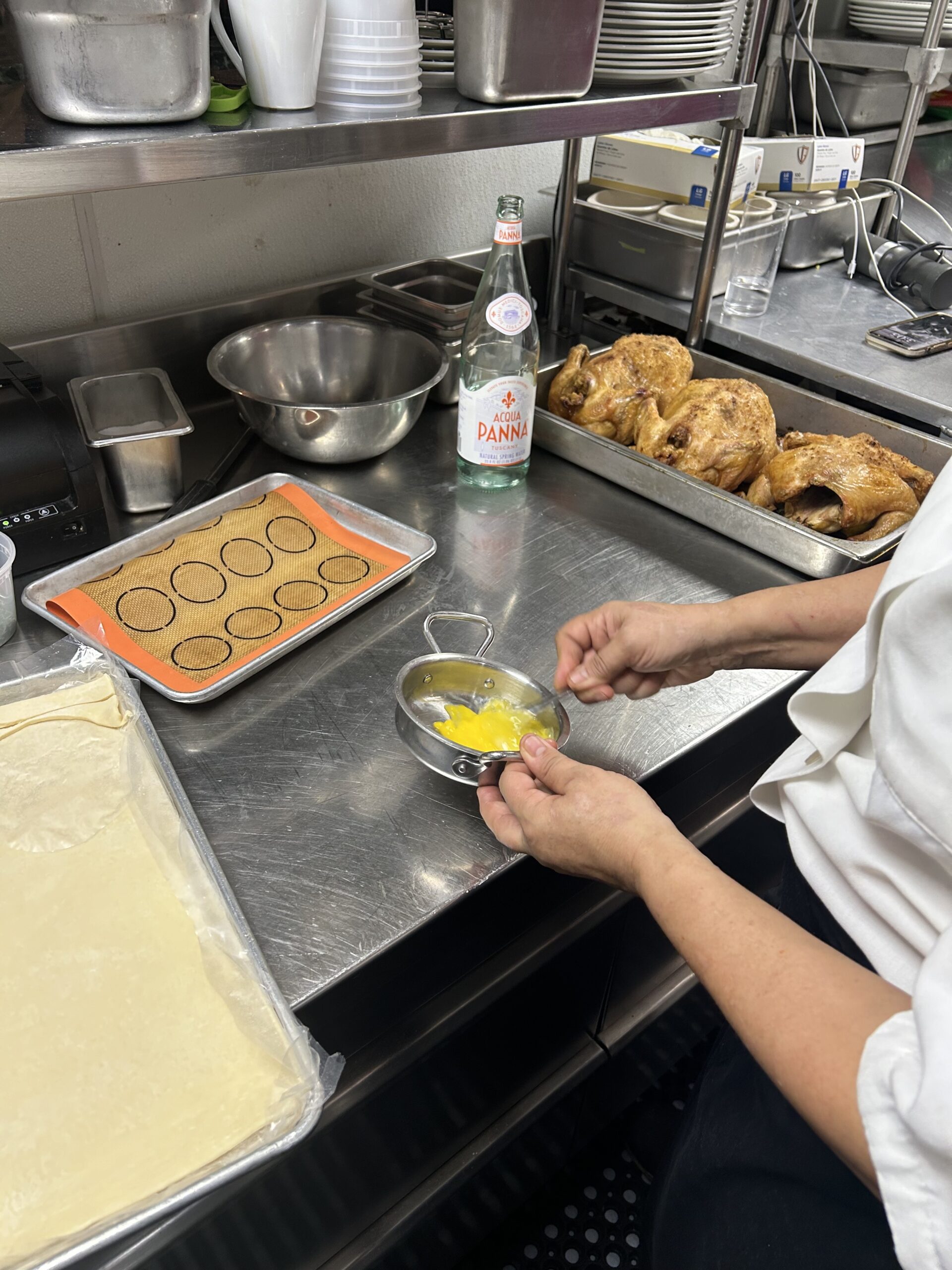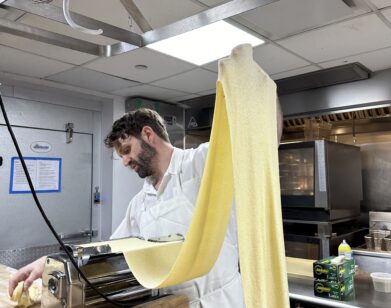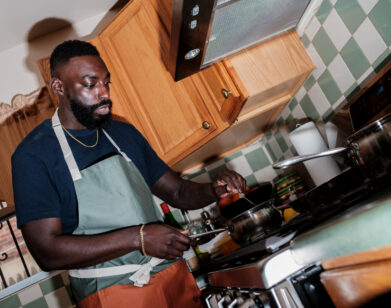LESSON
At Hoexters, Chef Mariana Mitsos Masters the Art of Upscale Comfort Food
It was three in the afternoon when the line cooks began filtering into the kitchen at Hoexters. A few weeks earlier, chef Mariana Mitsos had invited us to the Upper East Side restaurant to learn how to make their seasonal chicken pot pie. New York’s winter had just begun, and so too had the dinner rush. Our mirepoix got pushed aside to make room for a steaming pot of gorgonzola béchamel. Slices of bacon sizzled in the oven alongside trays of puff pastry dough. “Hoexter’s is the kind of place where we don’t pretend to serve food you can’t make at home,” Mitsos said. “This is comfort food for people you love.” A thermometer on the wall read that the temperature in the kitchen was nearly ninety degrees. If this was my initiation into a New York restaurant at its busiest, the smell of a freshly-baked pie just out of the oven placated the mayhem. But before I could take a bite, the chef, who hails from an olive farm in Greece, called for a prayer to the “gods of puff pastry.”
———
EMMA STOUT: I don’t cook. I’m new to this.
MARIANA MITSOS: Really? How come?
STOUT: I don’t know, I never learned when I was younger.
MITSOS: For me, it’s the opposite. We grew up with only my father in the house, so I learned how to cook very early.
STOUT: What’s your favorite kind of food to make?
MITSOS: That is a very difficult question. No chef likes this question, I have to admit. But I like cooking in the Greek style. In Greece, everybody just shares everything on the table. There’s loads of little things, and we just share. Sharing food adds something to the whole experience. It connects people, it bonds them.
STOUT: Chicken pot pie is a good family style meal.
MITSOS: I think so. It’s a comfort food, and Hoexters is the kind of restaurant where we do not pretend to serve food that you can’t eat at home. But what you’re going to eat here is always going to be the best quality and cooked the best way it can be.
STOUT: So we start by dicing the onion?
MITSOS: Yes, we’re going to start by dicing our mirepoix: onion, carrot, and celery. Then we’re going to put them in the pot and let them sauté a little bit. A secret about chicken pot pie is that none of the vegetables should become mushed, so the most important thing is the size of your dice. If you dice something really small and your potatoes really big, they’re never going to be good. Either your small dice is going to be too mushy, or your potatoes are going to be too raw.
STOUT: Would you consider yourself a perfectionist?
MITSOS: I think so, yes. All chefs are, but some a little more than others. I was a farmer before becoming a chef. That’s how I became a chef, actually. It brings you closer to what you eat. [Continues dicing onions] Okay, now the onion is diced. Let me just bring the little things I have prepped here. And for those of you who don’t cook, it is quite important to have sharp knives while you’re cooking. Your life is much easier.
STOUT: Do you have any kitchen scar stories?
MITSOS: So many. Look at me, I’m full of them. I’m a proud chef. Actually, I burned myself the first day we opened Hoexters with a pot of boiling water. That was really bad. Now, we cut the baby carrots, which are seasonal from upstate. We’re dicing them a little bit bigger than the onions, and we want them to all be the same size and have a bite when the chicken pot pie is ready.
STOUT: Is that what you’re doing during the day—prepping for dinner?
MITSOS: Uh-huh, I come here in the morning. I’m here with my prep cooks and my sous-chef. And then at 3:00 p.m. the line cooks come in. I’m going to also dice the celery a little bit smaller than everything, because I wouldn’t mind if it became a little mushy.
STOUT: What is the most important vegetable for the structural integrity of the pie filling?
MITSOS: The peas are the last thing I put in there, because they are very easy to mush. I think chicken pot pie, if any of the veggies don’t have their integrity, as you say, it’s not as pleasant. And if you pull the chicken too thin, it all crumbles.
STOUT: Right, it’s a bad mouthfeel.
MITSOS: Yeah, you don’t want to make baby food. [Chopping celery] Sometimes I wonder, why didn’t I just stay a prep cook? I love dicing, brunoising, chopping. The smaller and more detailed it has to be, the more I love it.
STOUT: What herb did you just grab? I love the smell that’s coming through.
MITSOS: This is parsley. We’re doing chiffonade, that’s what it’s called when you kind of shave the parsley very thin. You don’t go over it again and again. You just go through it once, as thin as you can.
STOUT: What else is in here? Thyme?
MITSOS: This is thyme, yes. So the thyme, you pick with your fingers. You can cut it with a knife, but just before putting it in the food. If I cut it and leave it, it’s going to turn black.
STOUT: Interesting. You have a whole system here.
MITSOS: Because the more things you need to do, the more of a system you need. That’s a fact. Now I’m going to cut the potatoes. The dice is quite important. It needs to be a small dice so in the same bite you can get more than one veggie. You don’t want one bite to be a potato, the next one to be chicken, and the next one to be a carrot. I need to rinse those mushrooms really fast and then I’ll be right back. [Leaves] All ready. I have my butter and my mirepoix. I have my little notes.
STOUT: In Greek, I saw.
MITSOS: I love it— it means that nobody knows what I’m writing. I have everything. I am ready to start cooking. I’m going to start with some butter. And I’m going to let it warm up a little bit, and then I’m going to put in the mirepoix. Mirepoix is always onion, celery, and carrot. This is classic. It’s in almost everything. The French use it, and we just obey. It adds flavor. The carrots are nice and sweet. And the onions caramelize beautifully.
STOUT: How do you know when your mirepoix is done?
MITSOS: You’re looking for the onions to be translucent. If they’re brown, it’s too much, and your carrots start being a little softer than just completely raw. After that, we’re going to add the potatoes, and they have to get a little bit soft also. After the potatoes, we’re going to add the mushrooms. Then we’re going to add the cognac—it adds a little bit of depth—instead of white wine.
STOUT: I love cognac.
MITSOS: Me too, so you can imagine. Then you let the alcohol evaporate, and it just leaves the taste underneath. It’s beautiful. We use cognac here also for our au poivre, and that’s why I had it in my mind when I was making chicken pot pie for the first time. A little bit of creaminess and the mushrooms, cognac really elevates both of these.
STOUT: Did you already make the puff pastry?
MITSOS: The puff pastry is ready in the freezer. We’re just going to egg wash it and put it in the oven and it’s going to be great.
STOUT: Is there a technique you learned when you were becoming a chef that blew your mind?
MITSOS: Emulsifying hollandaise is something magic. You add your oil and then suddenly it’s creamy when it comes out of the oven. But I have learned a lot of things being in New York and working with other chefs that I find very interesting. Greeks, we cook very simple food. Whereas here, it’s different. And I like that a menu can have different flavors, rather than just being one note. When I think of going home, I sometimes am scared that I’m going to lose that having the whole world in one city and in one bite. [Returns to dish] This is starting to look great. I’m using the cake tester to see how hot it is. A cake tester is a tool that chefs love using. You can check the temperature on everything. Now the carrots are starting to get a little bit softer…
STOUT: Is the chicken pot pie on the menu for winter?
MITSOS: Yeah, it’s going on today. We had it last year as a special and it would always sell out. But it’s one of the dishes that is easy during service.
STOUT: You just let it cook?
MITSOS: You just have to heat it up a little bit. Salt this and that. I’m just going to leave the onions on for one more minute, and then we’re going to put in the mushrooms. Then we’re going to put the cognac in and let it cook out. Then we’re going to put the chicken. This is exciting.
STOUT: That looks so nostalgic.
MITSOS: This is a classic food for people you love. I feel like that about this dish. I’m going to put some thyme. And now we’re going to put in the flour, cook it off, and make the roux. You just cook it off a little bit, five minutes. If not, it’s going to taste like raw flour. Now, I’m going to add the chicken jus. I’m also going to put in the milk.
STOUT: Just regular fat milk?
MITSOS: Yeah, regular fat milk to give it a bit of a creamy texture. You already see it, how it looks more like a chicken pot pie. The flour is going to thicken the sauce a little bit. And we’re also going to add the pulled chicken. And that’s where I’m going to add more salt. See how creamy it is?
STOUT: Yeah.
MITSOS: Oh my god, I want to eat it, don’t you? And then I’m going to add the peas.
STOUT: It’s so colorful.
MITSOS: I love peas, and they’re not very seasonal. Like carrots, you use them all year round. The filling is done. We’re just going to add the parsley.
STOUT: Stunning.
MITSOS: Let’s bring over the puff pastry. We’re going to cut it, egg wash, and put it in the oven.
STOUT: The little ruffles, it’s just an aesthetic thing?
MITSOS: Yeah. Also, it keeps the pastry together so that it puffs in the center more. Now we’re going to egg wash it. You don’t want to have excess egg, because it’s going to be like an omelet, but it has to be everywhere so that the color is nice and shiny. And then we’re going to put it in our oven and watch it puff. It will go very fast.
STOUT: We’re just waiting for the puffing.
MITSOS: I’m going to pray to the god of puff pastry. Another minute and it’s done. [Takes pot pie out of the oven] All right, this is our chicken pot pie, girls.













